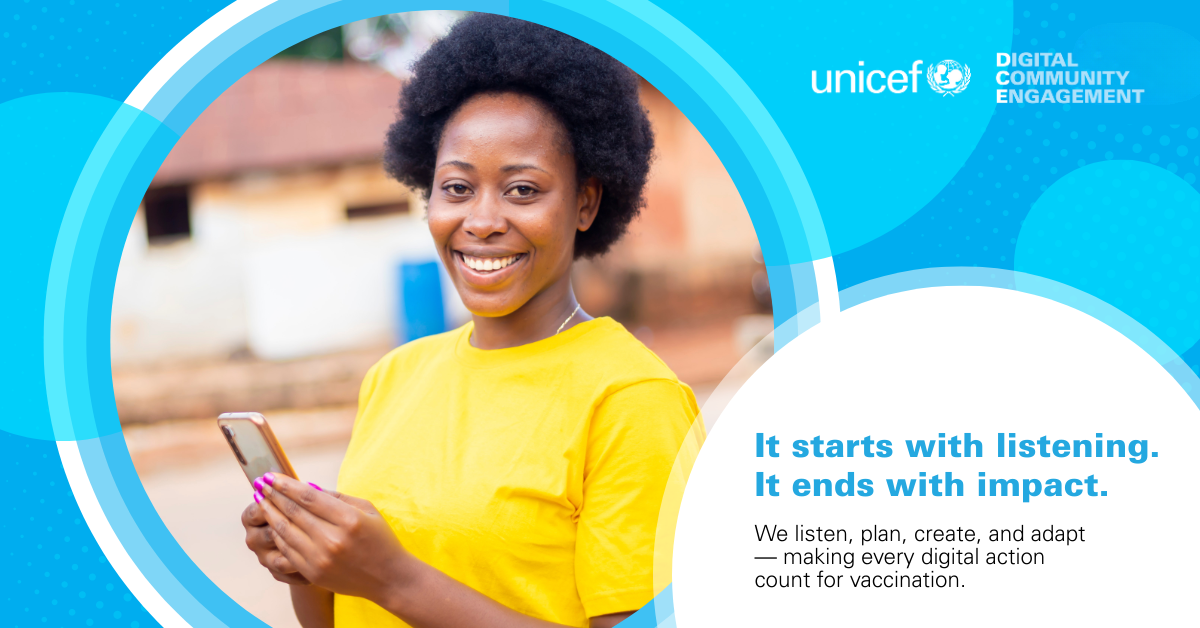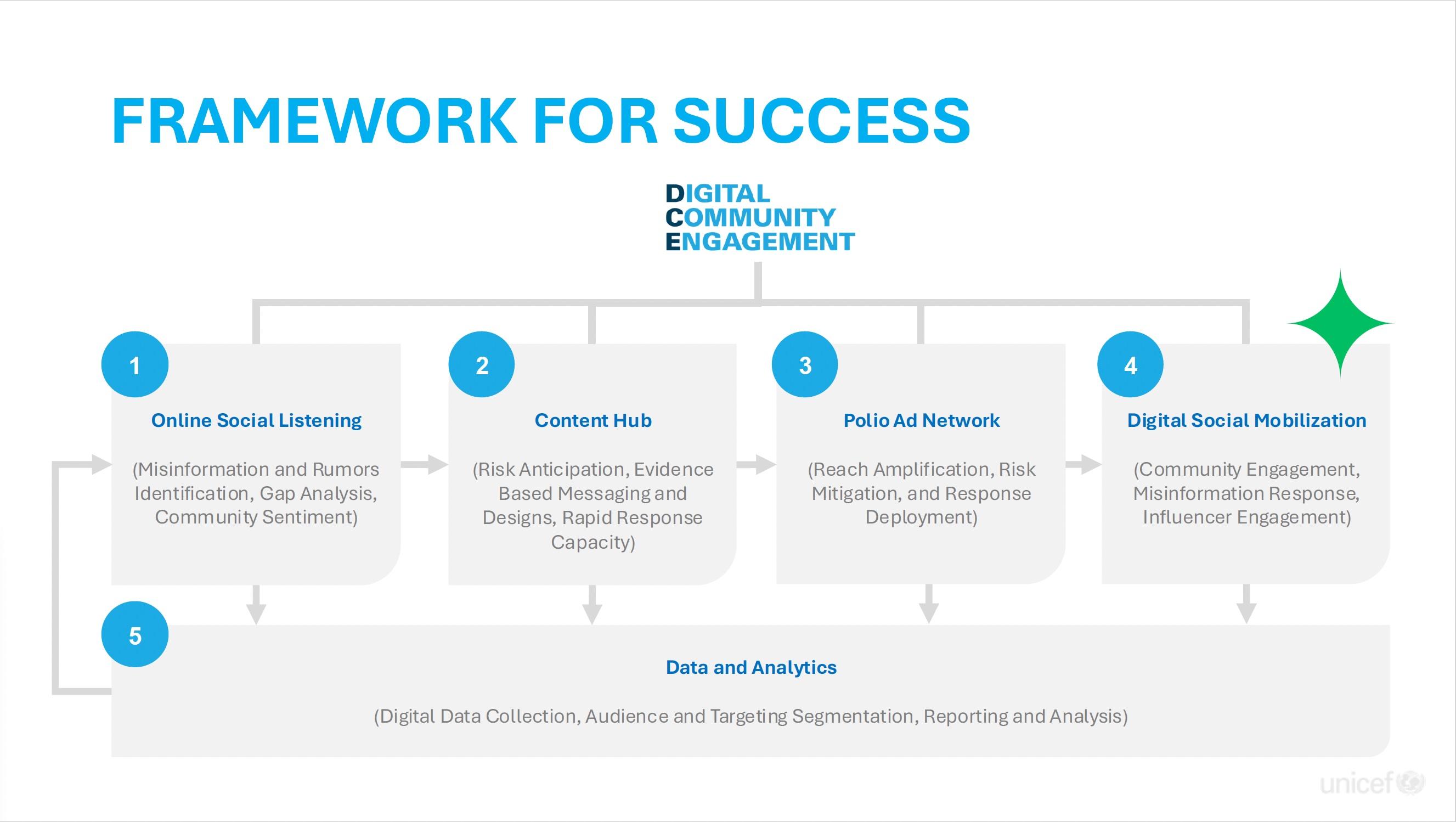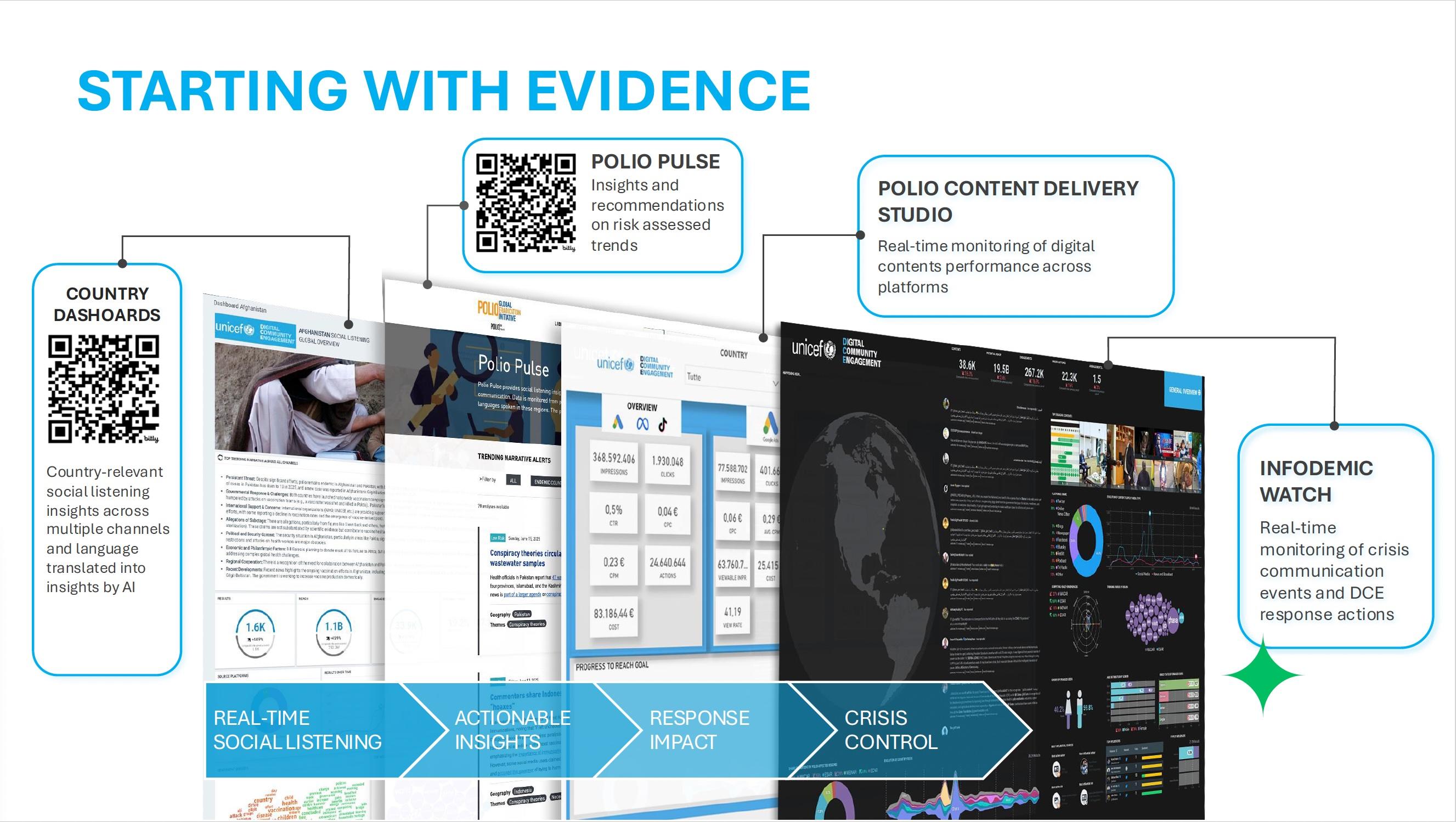Inside DCE: How Digital Campaigns Drive Measurable Change

Digital spaces have become one of the most critical frontlines in the effort to eradicate polio. As misinformation spreads faster than ever, influencing decisions in communities worldwide, UNICEF’s Digital Community Engagement (DCE) approach ensures that the right information reaches the right people at the right time.
In the last couple of years DCE has helped polio teams detect and respond to harmful narratives, amplify trusted voices, and support Country Offices with tailored digital campaigns that complement on-the-ground Social and Behaviour Change (SBC) work. Over 100 million people have been reached with accurate information through these efforts — not as a one-off push, but as part of an agile, evidence-based, and community-led process that adapts to local realities.
In this piece, we open up the DCE “black box” — showing how insights flow from real-time social listening to audience targeting, creative production, rapid deployment, and ongoing refinement. The process is built for speed, precision, and collaboration — and while it is a cornerstone of polio eradication, it also offers a model for digital engagement across other public health priorities.

1. Social Listening & Insights
Every DCE campaign begins with understanding what people are already saying. The team monitors public conversations on social media platforms, messaging apps, and community forums, using a mix of technology and human analysis. This enables early detection of misinformation, as well as opportunities to strengthen supportive narratives.
Insights are also gathered offline through SBC teams, frontline workers, and partner networks. By combining these sources, the digital picture reflects real community concerns and can guide campaigns that feel relevant, timely, and trustworthy.
Ahead of a synchronized vaccination campaign across five Lake Chad Basin countries, social listening revealed two distinct needs: in some areas, communities wanted more basic information about the campaign, while in others, misinformation about vaccine safety was gaining traction. This early insight allowed the team to design two campaign “rounds” — the first building trust and awareness, the second directly countering false claims.

2. Campaign Alignment with Country Offices
Once the landscape is clear, DCE collaborates with the Country Office to ensure digital plans fit seamlessly into the wider campaign strategy. This is a co-planning process, resulting in an “alignment document” that defines objectives, messages, timelines, platforms, and how online actions complement offline activities.
Country teams play a leading role in shaping and approving this plan, ensuring cultural and operational relevance. This step anchors DCE firmly in local ownership rather than external direction.
In Afghanistan, the first national DCE strategy was developed through a participatory workshop at the National Emergency Operations Centre. More than 40 participants — from frontline health workers to Ministry of Public Health representatives — helped define campaign priorities, audience personas, and messaging approaches, ensuring the digital work would directly reinforce field operations.

3. Audience Definition
With objectives agreed, the next step is to clearly define who the campaign is speaking to. DCE builds detailed audience profiles that capture demographics, languages, preferred platforms, and the narratives most likely to influence each group. This segmentation allows for targeted content that resonates with specific needs rather than generic messaging.
These profiles are updated as new data comes in, meaning the targeting strategy can evolve even mid-campaign.

During a Pakistan campaign, analysis showed that young parents on Facebook were engaging with content differently from those on YouTube. The team adjusted targeting parameters to reach each group with platform-specific formats, increasing both reach and click-through rates.
4. Creative Production
Once audiences are defined, creative work begins. DCE collaborates with country teams to develop platform-appropriate visuals, videos, animations, and copy in local languages. Content is rooted in the audience insights gathered earlier, and often draws from UNICEF’s broader message guides to ensure accuracy and consistency.
Multiple formats are produced for A/B testing — a method where two or more versions of the same content are shown to different segments of the audience to see which performs better. This allows the team to identify the most effective styles, tones, and formats before committing resources to scale-up.
For a campaign in the Lake Chad Basin, the creative package included simple text graphics for areas with low bandwidth, short videos optimised for mobile viewing, and influencer-led messages in local languages. Each piece was designed to match the technical realities and cultural preferences of its intended audience.
5. Real-Time Deployment & Monitoring
Campaigns are launched across agreed platforms, with careful attention to timing, sequencing, and budget pacing. Real-time dashboards track key metrics such as reach, engagement, click-through rates, and — where possible — indicators of intent to vaccinate.
This stage is highly collaborative, with global and country teams in continuous communication to troubleshoot technical issues and respond to unfolding events.
During a national campaign in Afghanistan, real-time monitoring flagged a sudden drop in engagement on one platform. A quick review revealed that posts were being published outside peak usage hours for the target audience. The schedule was adjusted immediately, restoring performance levels within 24 hours.
6. Data-Driven Adjustment
DCE treats campaigns as living systems, adjusting them in real time based on performance data. This can include reallocating budget toward higher-performing content, changing messaging emphasis, or adapting creative formats to improve resonance.
Mid-course adjustments are made collaboratively with the Country Office, ensuring that all changes fit the broader SBC and operational context.
In Pakistan, ongoing analysis during the campaign showed that certain message frames — focusing on community protection — were driving stronger intent to vaccinate than more technical health explanations. The content mix was quickly adjusted, leading to measurable gains in both engagement and intent.

7. Measuring Change
At the close of each campaign, DCE works with country teams to assess results against objectives. This includes traditional digital metrics, but also deeper indicators like shifts in intent to vaccinate or reduced prevalence of misinformation narratives.
Findings are documented and shared across the polio network to inform future campaigns — creating a feedback loop that strengthens both digital and offline SBC work.
In the Lake Chad Basin initiative, campaign data showed a measurable increase in positive sentiment toward vaccination across monitored digital channels. These insights were shared with all participating countries, guiding refinements for the next synchronized push.

The DCE process is more than a series of technical steps — it is a way of working that combines evidence, agility, and collaboration to address real-world challenges in real time. By starting with listening, co-creating with country teams, targeting precisely, and adapting quickly, DCE ensures that digital engagement is not just noise in the online space but a driver of measurable change.
While this approach has been honed in the fight to eradicate polio, its principles — grounding in evidence, local ownership, and rapid learning — are equally relevant to other public health and SBC priorities. In an age where the digital conversation can shape community decisions overnight, this model offers UNICEF a tested pathway to respond with speed, accuracy, and impact.


